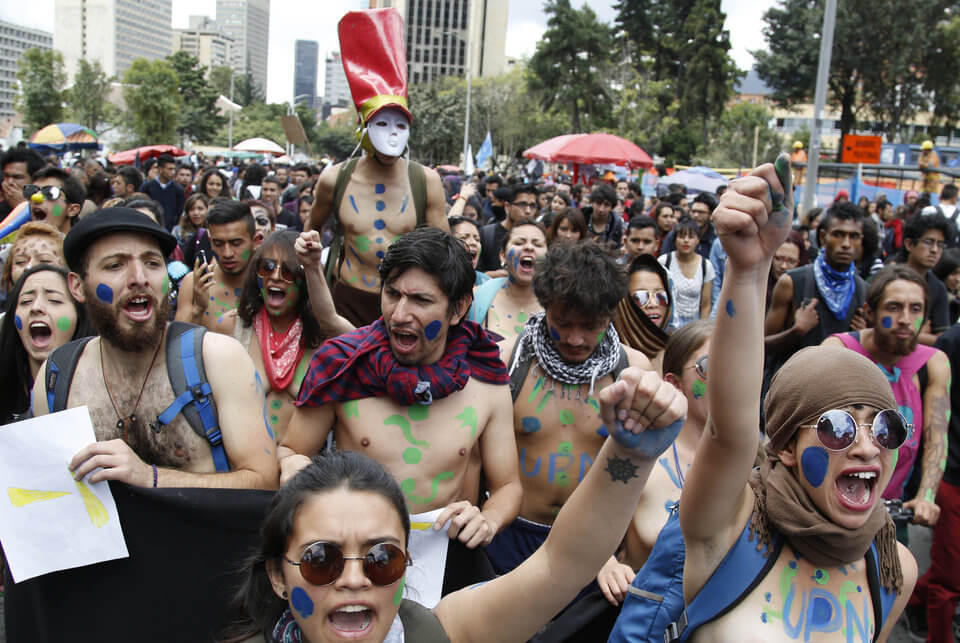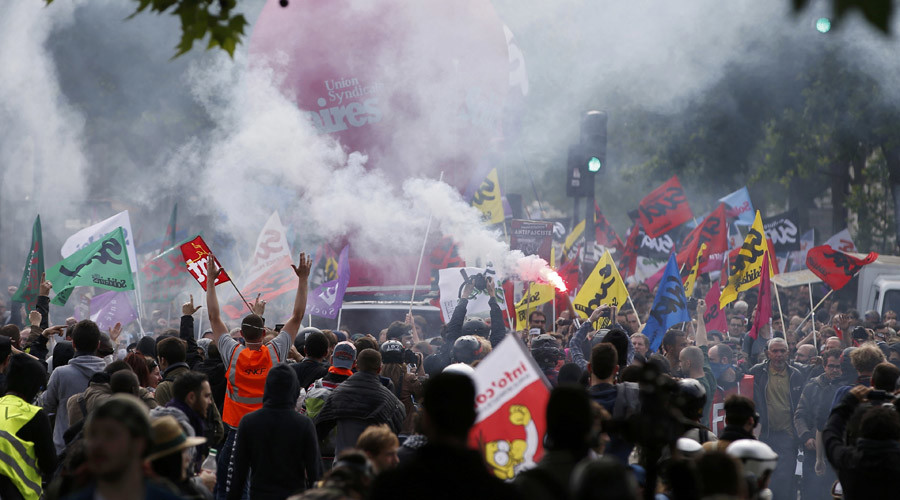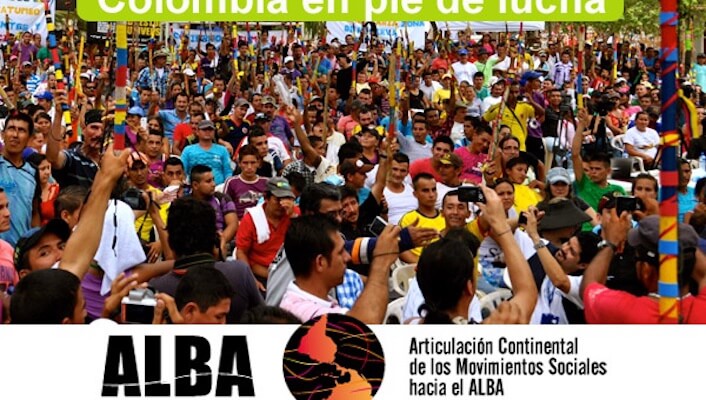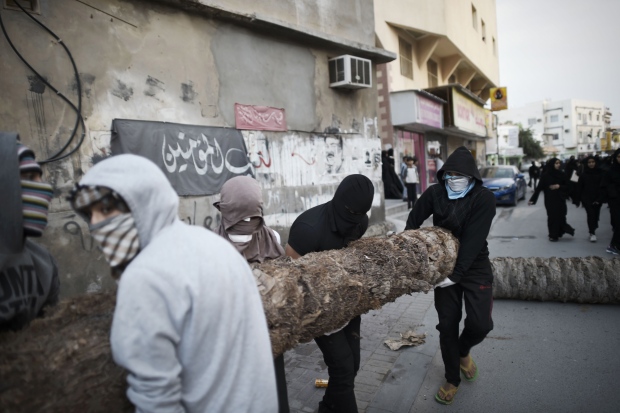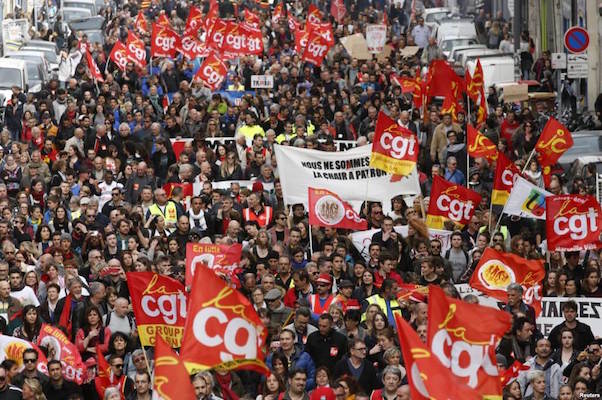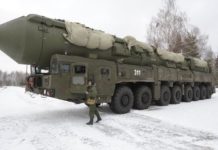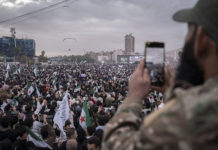Colombia Rural Strike Stands Strong as Police Repression Mounts
Source: TeleSur / the Dawn News / June 9, 2016.
Tens of thousands of peasants, rural workers, and Indigenous people in Colombia have been fighting against massive land inequality and privatization decrees, as well as the right to participate in the ongoing Colombian peace talks, under the banner of the Minga (Strike) of Resistance for Life, Territory, Dignity, Peace, and the Implementation of the Agreements.
However, this has been met by massive brutality at the hands of the Colombian riot police known as ESMAD who have attempted to crush the strikers with lethal force. Clashes have already left three protesters dead, as well as over 100 jailed and 202 injured.
Lawmakers are now close to approving a controversial legislation that would allow the police to enter private residences without a judicial warrant, carry out arbitrary arrests and criminalize protesters occupying public space.
Despite the martyrdom of the three killed protesters and the looming threat of increased repression, the fighting campesinos continue to struggle for their social rights, land, and basic dignity.
Colombia: Striking Rural Workers Warn of Looming Crackdown
Source Telesur / The Dawn News / June 8, 2916. Reports of violent repression by Colombian police takes place as lawmakers consider a controversial legislation that would violate civil liberties.
Colombia’s national agrarian strike entered its tenth straight day on Wednesday as thousands of citizens are protesting against privatization decrees, massive land inequality, and the demand to participate in the ongoing Colombian peace talks.
The strike of rural and agricultural workers is taking place throughout Colombia, with demonstrations and pickets shutting down several parts of the Pan-American highway.
Organizers of the national protests, which are being carried out under the banner of the “Agrarian, Ethnic, Rural and Popular Minga,” called for international protection after three protesters were killed, more than 200 injured and 100 were arrested.
According to the Cumbre Agraria, a social organization negotiating improved conditions in the countryside with the government, mobilizations will continue indefinitely until the government listens to communities and provides concrete solutions to their problems.
The Cumbre Agraria also issued a request to the Inter-American Commission for Human Rights to send observers to guarantee the right to protest is respected.
“We demand that the Colombian Ministry of Defense guarantee the right to social protest and respect the lives of the demonstrators,” Cumbre Agraria said in a press release on Tuesday.
Meanwhile, international civil society groups have also called on the the Colombian security forces to comply with international standards on the use of force and respect for basic civil liberties.
“We are calling on President Santos and the Colombian state to choose peace, to curb any violence when dealing with protestors, and to respond to the concrete, and legally justified, demands that protesters have made,” Sebastian Muñoz, Senior Programs Officer (Latin America) at War on Want, said in a statement on Wednesday.
However, the recent instances of excessive force by Colombian riot police take place as lawmakers are nearing the approval of a controversial legislative bill that would implement sweeping changes to the country’s national police code.
Under the proposed bill, the police would be allowed to enter private residences without a judicial warrant, carry out arbitrary arrests and criminalize protesters occupying public space.
Colombia: Agrarian Strike in Valle del Cauca
Source Resumen Latinoamericano / The Dawn News / June 6, 2016.
Since May 31, hundreds of indigenous men and women of the Nasa community are fighting against the Esmad in the route, when suddenly, the Cauca mountains gave as present one of the most beautiful natural phenomenon that can ever exist: two huge rainbows in the east formed a perfect arc, leaving those present, completly amazed. Berta, one of the greatest authorities in this community, shook her head when she understood Nature’s clear message: “Mother Earth is warning that danger is approaching”. According to the majority of the community, a rainbow means blood.
Believe it or not, the next day, after 3 days of indigenous Minga and of blocking the Pan American Highway as a means of political pressure, Gersain Ceron and Marco Aurelio Diaz died from gunshot wounds in clashes with police: “they were fired by masked men who were covered by police agents”, according to local witnesses.
The reasons why today indigenous, peasants and Afro-descendant peoples are mobilized across the country are based on “noncompliance on the part of the State with the agreements made in 2008 to the peasant and indigenous communities”, said Nelson Lemus, leader of the Nasa people.
Historical clashes of this community with the public security forces reveal a conflict that goes beyond a simple sectorial agreement with the government. According to Nelson Lemus, the issue is related to the agrarian model of the country .
Unrest in Colombia’s countryside: truckers join mass rural strike
Source colombiareports.com / The Dawn News / June 6, 2016. Colombia President Juan Manuel Santos vowed to personally attend talks to end ongoing mass protests in the countrysides, but not until June 22. Meanwhile, rural unrest appear to be escalating.
After a week of “Minga” as the protest is called, clashes with the police reportedly left three people dead, more than 190 injured and more than 150 in jail, according to Contagio Radio, a leftist radio station following the rural strikes.
The minga was organized to demand the government keep promises made in 2013 when similar rural protests were held, revealing massive resistance to the government’s economic policy that, according to the protests, prioritizes the interests of multinationals over that of Colombia’s rural citizens.
Following talks with top government representatives, the indigenous, afrocolombian, farmer and government representatives agreed to the establishment of a negotiations table to end the rural uprising that has mobilized more than 30,000 in the countryside.
According to Interior Minister Juan Fernando Cristo, the protesters agreed to lift blockades in the departments of Huila, Valle de Cauca, Nariño, Guajira, and Casanare.
In return, the government vowed to reduce violent police repression of the protests that have three killed and dozens injured, said the protesters.
It is unclear whether blockades in other parts of the country were lifted as well, but media reported that protesters had also begun taking government buildings in various parts of the country.
Protesters reported on Sunday that following the promise to reduce riot police presence, the army had been sent out to quell protests along the Panamerican Highway in Cauca at less than 40 miles from where talks were held.
Meanwhile, Colombian truck driving union ACC released a video announcing that they will be joining the strike on Monday due to — again — the government’s “non-fulfillment of promises.”
Leaders from the country’s other three main truck driving unions are also considering joining the strike, which would represent a total of 260,000 cargo drivers.
According to the ACC leader, the administration of President Juan Manuel Santos deceived them, and has barely fulfilled 10% of the promised measures to alleviate their plight.
The Minga began early last week, ignited by some 10,000 small farmers, mostly from indigenous communities, and started with blockading roads connecting Colombia’s largest Pacific port city Buenaventura from the rest of the country.
According to the Marcha Patriotica, a leftist organization that supports the protests, as many as 100,000 rural Colombians are taking part in the protests on some 60 locations across the country.
The government’s human rights agency estimated the number of protesters to be 30,000.
Read also: Political Declaration: Continental Coordination of Social Movements Towards ALBA















